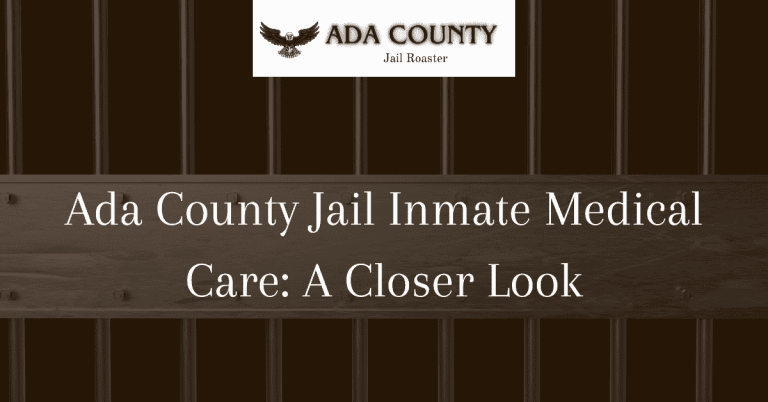Ada County Jail vs. Other County Jails: A Comparison
Ada County Jail and other county jails differ in several aspects, ranging from facilities and inmate population to programs and services offered. Ada County Jail, located in Idaho, stands out for its modern infrastructure and comprehensive approach to inmate rehabilitation. It houses a diverse population of individuals awaiting trial or serving sentences, with a focus on providing a safe and secure environment for both inmates and staff.
On the other hand, various county jails across the country may vary in size, resources, and programs available to inmates. While some jails prioritize vocational training and educational opportunities, others may focus more on basic incarceration and supervision. Understanding the distinctions between Ada County Jail and other county jails can shed light on the different approaches to corrections and the impact they have on inmates’ lives and overall community safety.
Comparing Facilities and Inmate Population
Ada County Jail in Idaho boasts a modern infrastructure that sets it apart from other county jails across the country. The facilities at Ada County Jail are designed to provide a safe and secure environment for both inmates and staff. From state-of-the-art surveillance systems to secure cells, the jail prioritizes security without compromising on the comfort of inmates. The inmate population at Ada County Jail is diverse, consisting of individuals awaiting trial or serving sentences for various offenses. This diversity adds a unique dynamic to the jail’s environment, allowing for interactions and experiences that contribute to inmate rehabilitation.
On the other hand, county jails in different regions may vary in size and resources, impacting the facilities and inmate population they can accommodate. While some jails may have limited space and outdated facilities, others may have more resources to invest in modernizing their infrastructure. The inmate population at these jails may also differ in terms of demographics and backgrounds, affecting the overall dynamics within the facility. Understanding these differences can provide valuable insights into how county jails operate and the challenges they face in managing their inmate populations effectively.
Exploring Programs and Services Offered
Ada County Jail stands out for its comprehensive approach to inmate rehabilitation, offering a wide range of programs and services to support inmates during their time in custody. From vocational training and educational opportunities to mental health counseling and substance abuse treatment, the jail prioritizes holistic support for inmates to help them reintegrate into society successfully. These programs and services are designed to address the diverse needs of inmates and promote personal growth and development.
In contrast, other county jails may have limited resources and infrastructure to offer a wide range of programs and services to inmates. While some jails may prioritize basic incarceration and supervision, others may struggle to provide adequate support for inmates’ rehabilitation and reentry into the community. The availability of programs and services can significantly impact the outcomes for inmates, influencing their likelihood of successful reintegration and reducing recidivism rates. By comparing the programs and services offered at Ada County Jail with those at other county jails, we can gain insights into the different approaches to inmate rehabilitation and their effectiveness in promoting long-term positive outcomes.
Understanding the Impact on Inmates’ Lives and Community Safety
The distinctions between Ada County Jail and other county jails have a profound impact on inmates’ lives and overall community safety. Ada County Jail’s focus on inmate rehabilitation and providing a safe and secure environment contributes to positive outcomes for inmates, reducing the likelihood of reoffending and promoting successful reentry into society. By prioritizing programs and services that address the root causes of criminal behavior, the jail equips inmates with the tools they need to make positive changes in their lives.
In contrast, county jails that lack resources and support for inmate rehabilitation may struggle to address the underlying issues that contribute to criminal behavior. Without access to programs and services that promote personal growth and development, inmates may face challenges in reintegrating into society and breaking the cycle of incarceration. This not only impacts the lives of individual inmates but also has broader implications for community safety, as high recidivism rates can strain resources and undermine efforts to prevent crime.
FAQs
What makes Ada Jail unique?
Ada County Jail in Idaho distinguishes itself from other county jails through its modern facilities and comprehensive approach to inmate rehabilitation. The jail is equipped with state-of-the-art infrastructure to ensure a safe and secure environment for both inmates and staff. Additionally, Ada County Jail offers a wide range of programs and services aimed at supporting inmate rehabilitation and reducing recidivism rates. These programs include educational opportunities, vocational training, mental health services, substance abuse treatment, and reentry support. By focusing on holistic inmate care, Ada County Jail stands out as a model facility in the corrections system.
How Ada Jail serves diverse inmates?
Ada County Jail houses a diverse population of individuals, including those awaiting trial and serving sentences. To cater to the varying needs of inmates, the jail provides specialized programs and services tailored to different demographics. This includes gender-specific programs, mental health services, substance abuse treatment, and educational opportunities. By addressing the unique needs of each inmate, Ada County Jail aims to promote rehabilitation and successful reentry into society.
What’s on offer at Ada County Jail?
Ada County Jail offers a wide range of programs and services to support inmate rehabilitation and reduce recidivism rates. These include educational opportunities, such as GED classes and vocational training programs, to help inmates acquire valuable skills for reentry into the workforce. The jail also provides mental health services, substance abuse treatment, anger management classes, and parenting courses. Additionally, Ada County Jail offers reentry support programs to help inmates successfully reintegrate into society upon release. By offering comprehensive programs and services, Ada County Jail aims to address the underlying factors contributing to criminal behavior and promote positive outcomes for inmates.
Ada Jail: How Keep Inmates Safe?
Ada County Jail places a high priority on inmate safety and security by implementing strict protocols and procedures to maintain a secure environment. The jail has trained staff members who oversee inmate supervision and ensure compliance with rules and regulations. Additionally, Ada County Jail utilizes modern technology and surveillance systems to monitor inmate activity and prevent incidents. By prioritizing safety and security, the jail creates a conducive environment for rehabilitation and supports the well-being of both inmates and staff.
How do county jails affect safety?
Ada County Jail and other county jails play a crucial role in maintaining community safety by incarcerating individuals who pose a risk to society. By providing secure facilities and effective rehabilitation programs, these jails aim to reduce recidivism rates and promote positive outcomes for inmates. Additionally, Ada County Jail and other county jails collaborate with law enforcement agencies, courts, and community organizations to address the root causes of criminal behavior and support the overall well-being of the community. Understanding the impact of these facilities on community safety is essential for developing effective strategies to prevent crime and promote public safety.







